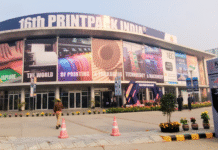
Heidelberg and Heidelberg India are no longer shying away from talking about their Chinese manufacturing plant near Shanghai. Probably the best investment by the company in the last 16 years, it is crucial for the cost-effective manufacture and sales of presses for the world’s biggest offset press market, China. It also works well for many of the workhorse multicolor presses needed by Asian printers, including Japan. Indian printers frequently visit China and take part in trips to the factory an hour’s drive from the center of Shanghai.
The Shanghai plant itself is word-class and uses core German manufacturing techniques, component testing, assembly, and testing for increasingly longer and more automated presses. Heidelberg Shanghai is also where the new smaller than B1 in-between format CS 92 press was manufactured with an eye on the Asian market and to compete with similar sizes produced by Komori and RMGT. The new press has led to considerable savings in firmware costs and consumables for commercial printers and has typically made its way into their migration to monocarton printing. Not surprisingly, the CS92 has also made its way to printers beyond Asia.
In its CEO Rainer Hundsdorfer’s relentless pursuit of viability and restructuring, Heidelberg has embraced the Shanghai plant openly. Recently it has even more closely aligned itself with its Chinese minority anchor shareholder Masterwork. And whose die-cutters, foil stamping, and folder gluer equipment are now part of its packaging solutions.
Heidelberg & Materwork jointly to construct an automated intelligent printing equipment production line
In early December 2020, Heidelberg revealed its plans to strengthen the partnership with Masterwork. Expanding their strategic cooperation, the two companies are jointly constructing a new automated intelligent printing equipment production line at Masterwork’s 328-acre site in Tianjin.

The CS92, only manufactured in Shanghai, is built on the solid Speedmaster CD 102 platform, with a maximum speed of 15,000 sheets an hour. Integrated with Heidelberg’s Prinect workflow for intuitive and straightforward operation, the Speedmaster CS 92 is popular with commercial and packaging printers in Asia and India.
The sheet format, plate size, and other features serve the needs of a printing market in which print runs are getting smaller and job changes more frequent. Printers are keen to increase productivity and reduce capital investment, overheads, and consumable costs. The company has sold and installed 63 printing units of this series in recent times.
The Speedmaster CS 92 4-color presses can print on paper from 0.3 millimeters to 0.6-millimeter thick board. The 63 CS92 press units sold across India include several repeat purchases such as Rahul Print O Pack and Replika Press. There are other takers for a press that helps commercial printers who are looking to monocarton printing and converting for survival and growth.















